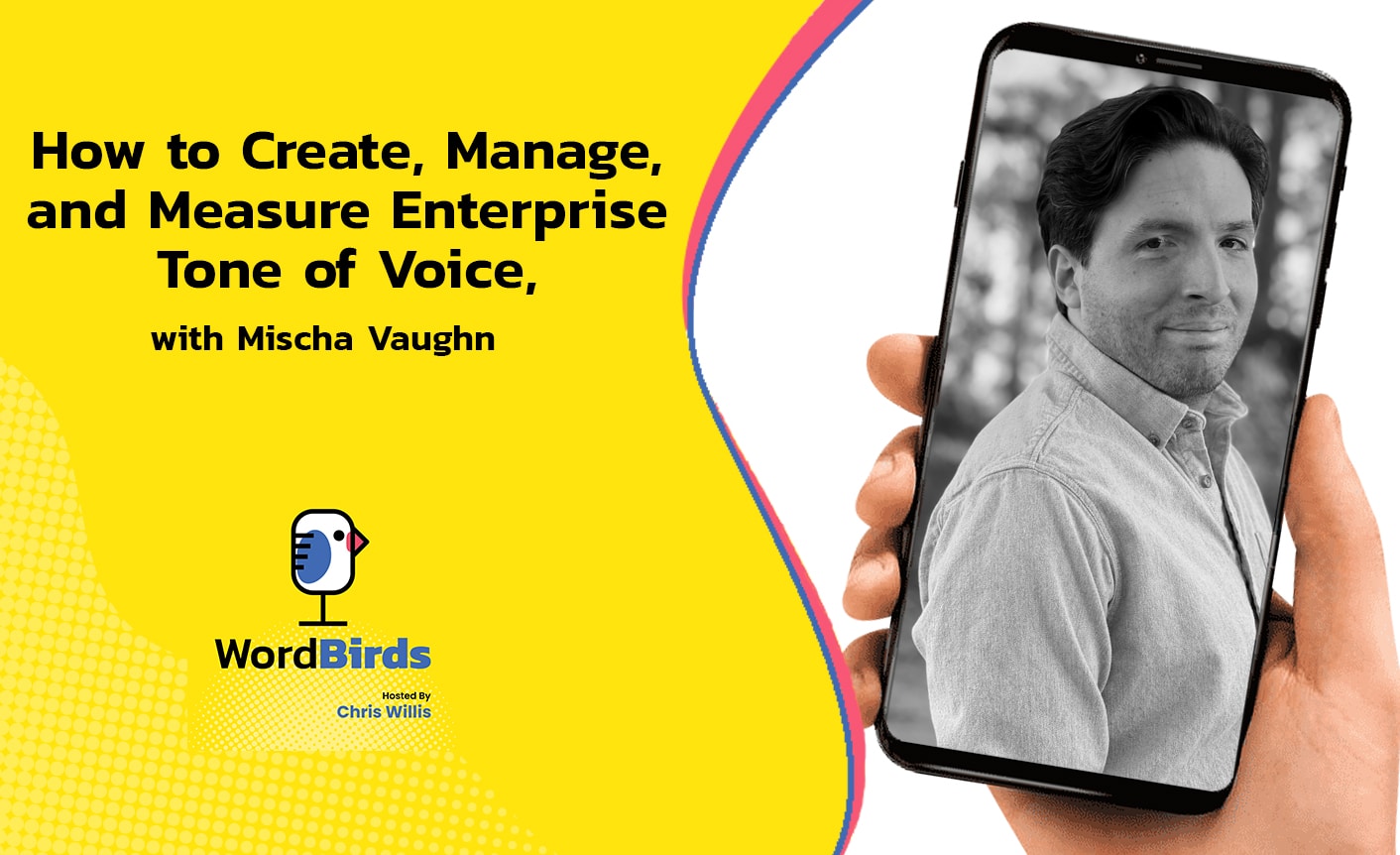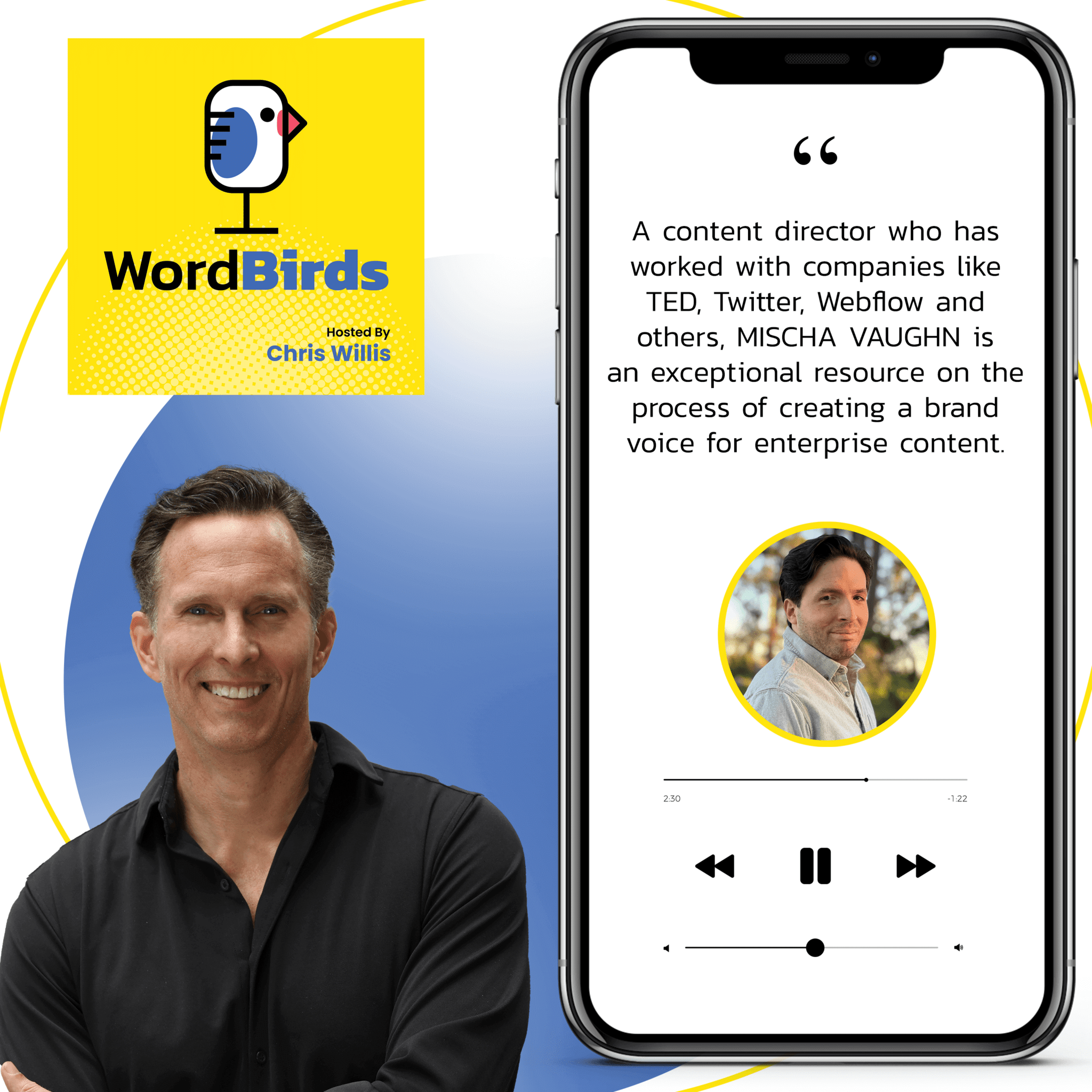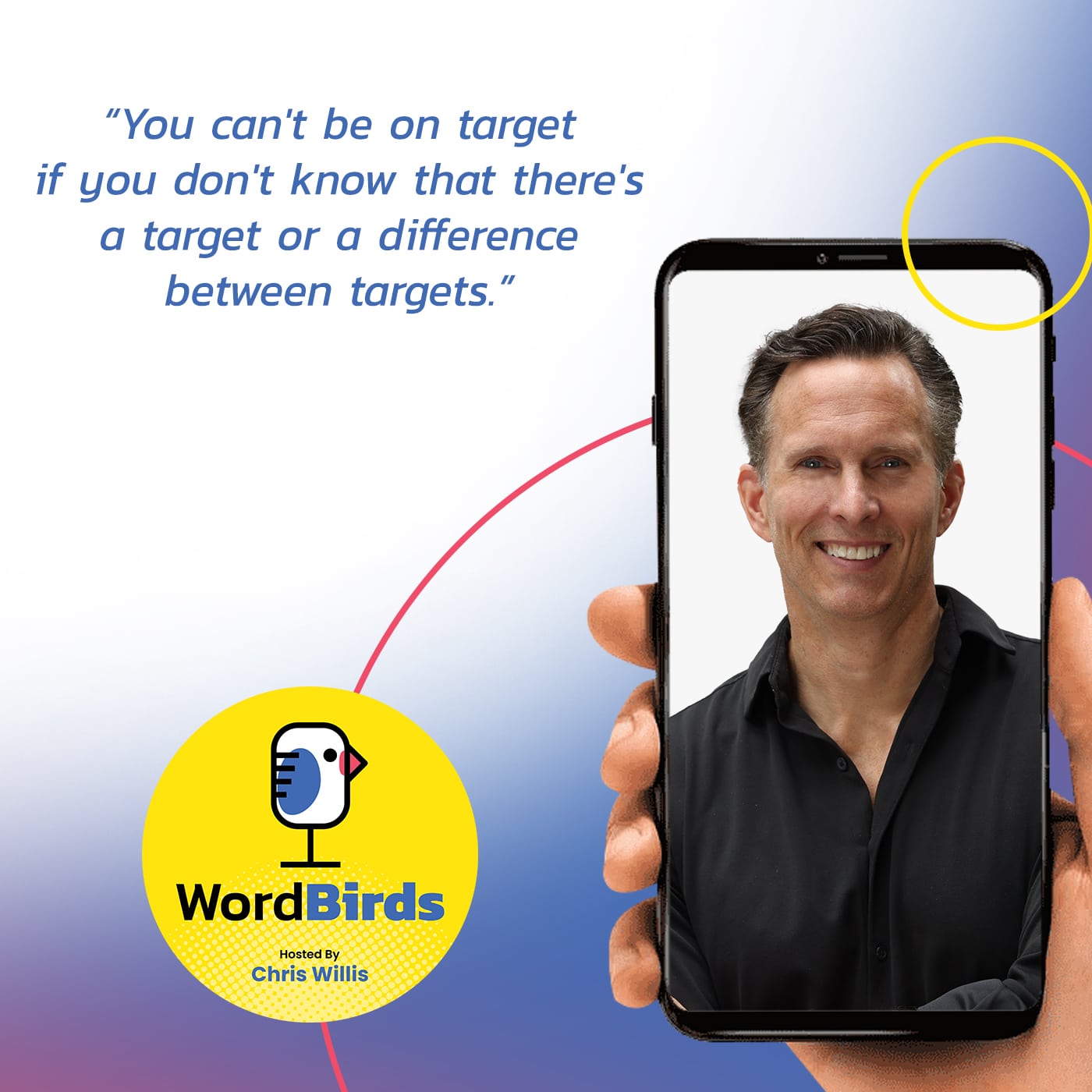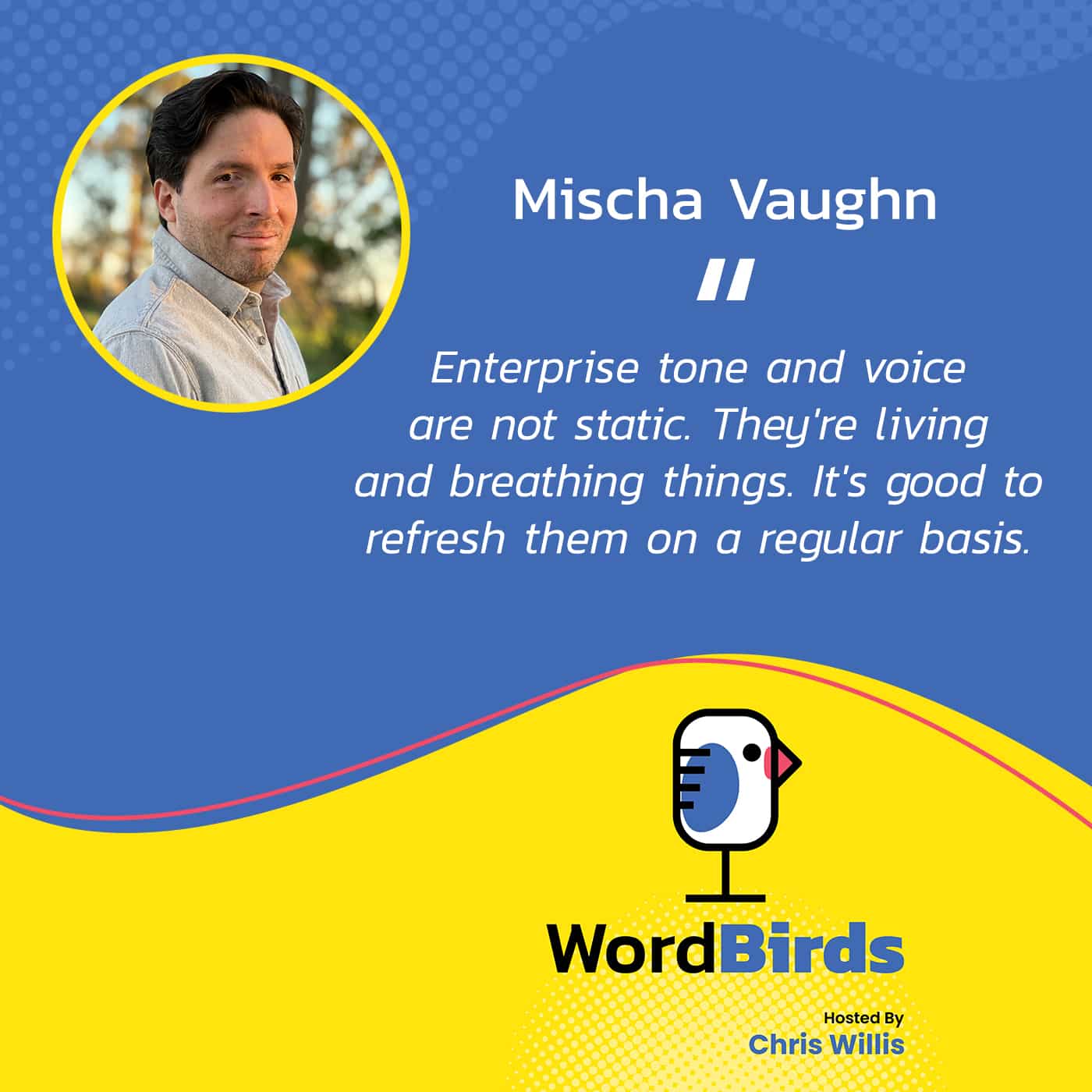How to Create, Manage, and Measure Enterprise Tone of Voice, with Mischa Vaughn

One thing that many businesses often lose sight of is the importance of creating a corporate voice – a brand voice that the company is going to be known for. As a brand, you want to have a specific sound that attracts your target audience.
Mischa Vaughn joins us on this episode to describe the process of creating, managing and measuring this enterprise tone of voice. Mischa is a content director who has worked with companies like TED, Twitter, Upworthy, and others. He currently works as the Head of Content at Felicis. This depth and breadth of experience that Mischa has makes him an exceptional resource on the process of creating a brand-specific voice in content creation.
Join in as he takes us through the nuts and bolts of that process as it happens in these massive companies and pick up some lessons that will help you do the same in yours.
Watch the episode here
Listen to the podcast here
Read full episode transcript
In this episode, we have Mischa Vaughn. He is a Content Director from companies such as Twitter, Upworthy, Webflow and others. We’re going to be talking about identifying and building the voice of a company, creation and how creation is only the beginning because you’ve got to get that content out to your end users. Let’s sit back and get some insight from the flock.
Mischa, welcome to the show.
Chris, how’s it going?
I’m good. Not too bad at all. This is going to be an interesting conversation. Looking at your background and what you do in the content space as a Director of Content, the first thing that I noticed is that you’ve taken the time to think through building the voice of a company.
That’s something that gets lost in a lot of businesses. We want to sound like something and specifically something that attracts an audience. What do you think about the creation of the corporate voice, the brand voice and any examples of companies that are doing it right out there?
I think of a company’s voice in a couple of ways. One of the reasons why I mentioned it is because I studied creative writing in college and there’s so much that is written about how individuals find their voice and how you can work on your voice and tone. There’s so much to help individuals in their writing but there isn’t a lot that’s written or even discussed about how a group of individuals like a company might find their voice together.
The way that I think about it, there are two key components to finding a company’s voice. One is the messaging, which requires everything from your product differentiation, your core audiences and why it matters to people. That has to be done usually in heavy partnership with leadership and product marketing with very tight coordination to them. Also, there’s your voice and tone. Your tone and voice are two very specific things.

The voice of your company shouldn’t ever change. The voice of your company should be, “This is what we stand for. This is what we believe in,” but your tone does change. Your tone changes based on the formats that you are working in. It could be a blog post, email, or social. All those channels have different tones. You might be a little bit more informal on social versus a sales deck, for instance.
It’s important to note that and note how your voice translates across those channels. This is something that we did when we redid our tone of voice at Webflow. This was my first time redoing a company’s tone of voice, which is interesting. I’ve built it from scratch before at other places that I’ve been but this is the first time I’m seeing what was there. It was interesting to see because there was a lot that was there that wasn’t helping writers or helping people at the company who do a better job.
There’s a lot in there about their North Star and this thing of why they exist. There’s a persona and stuff. All of that sounds helpful but when you have it together, you can have too much information. The tone of voice to me is very clear, “Here’s how we say things.” Even sometimes specifically, here are things that we don’t say. Sometimes you even go, “Here’s how we refer to products. Here’s how you talk about your competitors and stuff.”
The tone varies based on the channel. If you’re producing something that’s more education focused versus something that’s more targeted at sales, social, or even an ad if you will. That was fascinating to take this granular approach. We worked with a wonderful consultant. Her name is Anna Pickard. She is the person who wrote Slack’s tone of voice. The fact that Slack still has such a consistent tone of voice is so impressive.
I remember it was about summer. It was around June or July of 2020. Slack went down for about 4 or 5 hours. It’s a significant amount of time. Webflow is a very Slack-heavy culture and it disrupted our day and many companies. When they came out after the fact and on social media, they had such an honest and authentic explanation of what happened, how they failed and what they’re doing to do it. It was like, “This happens sometimes.” It wasn’t dismissing it under the rug but it was honestly like, “This does happen on occasion and it’s not acceptable. It’s something that we are working on.”
Your voice of your company shouldn't ever really change. It should be what you stand for, what you believe in. But your tone does change. It changes based on the formats that you are working in. Share on XThey did it in such a way that they were also thanking people for sticking with them and putting that customer-centered approach so focused on their message. That’s something that Anna built during her time there. The fact that it continues even after Anna has been gone from Slack and that tone is still there shows me that it’s a company that does it so well and it’s persisted. It’s been so strong even after the person who birthed those guidelines is gone.
How do you manage that in the business though? You identify whom you want to be and how you want to feel to your audience. How do you operationalize that? How do you take, “I want to be witty and wise but not arrogant,” and turn that into operational content creation? How do you make that run across a company?
One of the copywriters at Webflow, Kate Marshall, worked on this and helped lead this voice and tone refresh that we did. She and I conceived a bunch of tactics. She came up with some directly herself and I’ll walk you through them. For this tone of voice refresh, we did a presentation at the company, high level, “Here’s what needs to happen.”
Also, Kate gathered all the writers from Webflow and this could be not necessarily everybody but some of the leaders on the support team, some of the leaders on the sales enablement side and the leaders on the product marketing side and gathered them. First off, we took in their feedback like, “What’s working with the tone and voice now? What are the things where it’s failing?” We gathered their feedback before we redid it.
Once we redid it, we said, “Here’s this new guideline and how we use it. Here are some examples.” Even in this presentation, the phrase is, “How do we make it more in Webflow’s voice? How do we do that?” There was an interactive component that was recorded. It went into the learning management system and is a thing when employees are onboard. It’s one of the fundamental things that they intake so they understand regardless of what they’re writing. If they’re a lawyer, they understand, “If they’re writing something that’s coming from the company, they understand how to do that.”
There also are other things that we did that are a little bit more deliberate. We have these open office hours where people could come and bring something that they were writing and say, “Here’s something I’m writing. Is this on brand? What are some ways to fix this?” Some actionable ways to fix that in real-time, which then they take those learnings and do that for the next time.
The plan that is still being implemented is to implement a writing workshop at a company. I’ve done a ton of writing workshops in my day but it’s something that companies can do. I’ve heard of companies and I know a friend of mine who’s one of the cofounders at Monzo Bank, which is based in the UK. They have this strong writing culture and a whole writing workshop where for a whole day, the whole company does writing. Sometimes, those turn into blog posts. Sometimes they turn into different things.
You can go that far but what we were thinking for Webflow was a small cohort of 8 to 10 people and they would come on. Week one might be learning the tone of voice. The second thing might be, “Here’s how we do social tactics and email.” It’s giving them the full gamut of, “Here’s how we apply this tone of voice across these different channels,” so they’re aware of how to operationalize it and take that back with them. Also, maybe quarterly workshops like that where you do have a small group of people who are invested, learning together, learning from each other and have that culture spread throughout the company.
From a manual process standpoint, that’s optimizing across that group in a way that would work and allow people to maintain that voice. I’m lucky I had my fifth anniversary in 2022 at this business. I would’ve never expected that it would happen. The founder and I sat down and said, “It’s time to refresh the tone of voice.”

We sat down and did an exercise. We identified whom we want to be from a personality standpoint. It should be no surprise to anybody that’s ever worked with a CMO and a CEO that it turned out to be a combination of the two of our personalities. We want the company to sound like us. That’s great but the operationalization aspect of it is what do you do with a description of a person?
We put tactics to it. If we want to sound personal and not stodgy and modern but not trendy, what does that mean? It means no buzzwords. It means using contractions where possible instead of writing out both words. There’re several things that we can do. The neat thing about where I work is that we have this software that takes all that and governs it across the whole business.
A fun story is I put this into our software and I get the whole front office using it. Sales, marketing, our BDR team and customer success are using this new clarity-level tone of voice that we’ve built in and the terminology that we have that we want to very specifically use. It worked. It’s great. People appreciate it. They engage with our content.
In true CMO form, I’m a megalomaniac. Who else can I control? I want to govern everybody. Who writes content here? The support team writes content. Do you know who doesn’t think that my tone of voice is cute? Our support customers. I have a quick question. I need somebody to answer it. We’re writing back quippy little comments and that’s where you learn about your audiences.
One of the things that you talked about in the notes was that audience identification and understanding whom you’re communicating with and what’s going to resonate with them. How do you take that tone of voice and that entire governance model that you’ve created and then adapt it to your audiences?
It’s something that you do by having a spectrum of content and the voice that you apply is a spectrum. You’re not going to be fully corporate or fully casual, probably pretty rarely. We did set up this system where we have this corporate on one side and casual on one side. If casual is a 0 and the corporate’s a 10, we say, “For this particular piece, where should the range be? Is it a 7 that leans more corporate or is it a 2 and leans more casual?”
Maybe it’s something that you can define for your support team to say, “Support needs to be pretty in the middle. It needs to be pretty keel. It can’t be too casual.” It has to be a little bit more on the side versus if you’re doing something that’s more sales, yes, you have something more corporate. At the same time, you mentioned, “No buzzwords,” but the truth is for some people, especially if you’re working with a technical product or you’re explaining something, sometimes those buzzwords serve a purpose.
You do need something there because if you’re always trying to say something in the simplest terms, you would describe a computer as this box with screens, you do need these terms and stuff to help explain it. Sometimes if the buzzwords are clear for that audience, it’s fair to use. What you don’t want to use is words like synergy and things like that unnecessarily which may add unnecessary confusion on behalf of that. That’s what you do. You have to figure out within your tone of voice where are your spectrums.
Another one that Webflow has is humor. Webflow’s educational materials are very humorous but you won’t see Webflow inserting random jokes into things all the time. It’s more like, “The humor needs to be applied when possible and stuff too.” Honestly, the humor doesn’t necessarily work for everyone. It works for a lot of people but some people might find it interruptive to their style of learning. It’s something that the team has decided, “This is something that works for us.” Humor is something too where you can very easily be done poorly at companies.
I’ve seen things where companies are doing something that they think it’s clever and it comes off as mean. You need to have this careful brush when you’re applying these principles. That’s why it’s helpful to have a spectrum. If you say, “We’re going to dial this up to a five on the humor scale. For this announcement, we’re going to keep it a two. We are going to keep it a little bit more serious but maybe have a little cute sign-off at the end.”
It’s knowing how your audience wants to hear from you and how they want to consume your content. If you don’t know that, you’re off target. You can’t be on target if you don’t know that there’s a target or a difference between targets. That leads to success measurement. You’re doing all this. You’ve identified the tone of voice and you’ve built content that’s specific to your audiences. How do you know it works? How are you gauging the success of your content?
There’re two ways to gauge success, especially when you’re working with creative work. You can have your success metrics where here’s the impact that it made. For a piece of content, it could be the traffic that it garnered, the number of subscribers you got, the number of signups, or the number of leads generated. There’re all those classic measurements that we all know about.
You can even look at retention and the number of pages that they visited from it or whether it’s ranking in search. There’re a lot of metrics you can do. It depends on the intention that you have. At the same time, from the voice perspective, it’s helpful, especially for pieces that require a significant amount of investment to have creative goals.
From the voice perspective, it's really helpful to have creative goals, especially for pieces that require a significant amount of investment. Share on XThose goals could be like, “This is the message we want to create. This is the feeling we want people to have. These are even the types of people we want to share it with.” From that, you have to do a little bit more investigation, whether it’s a month or a couple of months after the fact. You try and maybe collect stories from salespeople like, “Did anyone use this at all in talking to a client or a potential customer?”
At the same time, you have to think purely from the creative execution point. Bringing that team together. “Of our goals, the themes and the messages we were trying to impart, did we feel we achieved our goal?” Also, you bring the stakeholders together and you have to have an honest conversation there. Maybe you say, “We tried something. Honestly, these jokes didn’t land,” or something.
You also can search on social media, whether it’s Twitter, LinkedIn, or Instagram and see, “What was the reaction to it? Were people playing along with us if that’s what we wanted to do? Were they playing along with us when we didn’t want them to do that?” That’s important to get that kind of calibration. That pretty much only happens in retrospect.
You have to be diligent about doing it. You can set up a template for doing it. Once you have that information, you can course correct your tone of voice. Tones of voice are not static documents. They’re things that can be living and breathing. It’s good to probably refresh them on a more biannual basis, I’d say at the least. These types of retrospectives can help inform that.

We’ve spent a lot of time talking about the creation of content. We’ve looked at building a tone of voice, identifying your targets and measuring the success of that creation. Is that it? Is that all we care about? I feel like the answer is no.
Not at all. It’s something I encounter a lot with content teams. Creating content is a lot of work. It’s about 80% of the work but like the Pareto Principle, there’s 20% of the work that probably creates 80% of the impact and that is distribution. I think of distribution very holistically. It comes from my time working in media. I worked at a company called Upworthy back in the day. They ruined Facebook for a lot of people between 2012 and 2014 but Facebook’s ruined for everybody so it’s okay.
Creating content is a lot of work. It's about 80% of the work. But there's 20% of the work that probably creates 80% of the impact. And that is distribution. Share on XAfter we wrote the piece that we were doing, we did a lot of work on headlines. We had to write 25 headlines for every single piece that we did. The reason we did it is that some people write the headline first and that’s it. The headline matters so much. Even the image you pick to get people to click into it matters so much. We had the system for testing and optimizing that. It’s funny to learn what number range you were in for the headline. I was typically an 8 to 13. It was my sweet spot.
Now, I don’t write 25 headlines but I do write about 10 or so. I have some methods for trying to use. Sometimes you do one with a number. Sometimes you do one for a specific type of person. One that’s very simple and one that uses a random word that you want to highlight. That’s even the headline part of distribution but if you think of all the work you do, you could write the best blog post on starting a podcast but if you don’t do any work to get it in front of people, no one’s going to see it. It’s going to have no chance of impact. You’re not going to be able to glean, “Was it successful or not,” whether it’s from a creative angle or an impact angle.
Every content organization needs to have a clear checklist and it’s usually based on content type. It’s also based on the audience type of where it goes, what you do with it and how you get it in front of people. That’s everything from how it’s optimized for search because you shouldn’t be writing stuff just for search, especially with Google’s recent updates. You should be treating search as a distribution tactic.
What email lists are you putting it on? What forums can it go on? Are you sharing on social media? How often? How are you also reconstructing that argument too? You’re not only putting the link out there but maybe you put it into a thread on Twitter or something. You can distill it into quotes on Instagram. There’re a lot of ways to reuse content and get that idea out there. Especially for more brand or thought-leading content, the important thing is the idea and getting that out there versus getting people to a specific link.
Yes, you do want to do that for more performance-driven stuff and growth-driven content but you need to think of how you are distributing this idea. How are you getting in front of the most people? What’s the right way to do that? In every business and industry, they’re going to have the right channels for us. Reddit might be an important thing if you have a specific Reddit community. For other places, it may be Facebook groups that are out there.
You need to hone your distribution list as much and even if possible, have people who are focused on that audience development. That audience development is a whole separate conversation but that’s not only about distributing the content. That’s about engaging with the audience where they are and making it so they want to stay following your brand. They’re getting value from you and you’re not only trying to always get them to do something.
That starts to change the way that you think about your success metrics. We’ve talked about success metrics of the content process in your business starting to look like retention, product usage, or sales. That’s what the purpose of content is. The thing that gets lost in the business is if you think in terms of content, you think of content marketing. That’s some content in a business but there’s content everywhere.
There’s product content, technical documentation, product manuals, educational content, service and support content, marketing, and sales. There’s all of this content floating around and none of it matters a bit if it’s sitting on somebody’s desk. It all needs to reach its intended audience. We reach out and talk about the company’s enterprise size and the size of companies that we sell to.
We try to pitch this idea of cost savings. We can help you save money in your content creation and the most interesting thing happened. These huge businesses said, “Great, cool. Point to the line item on my budget where I’m spending money on content.” It’s people. It’s your headcount. Everybody comes to work, a byproduct of what we do during the course of our days, the creation of content.
Everybody’s involved in this. We can help a business understand that aspect of it and get to a model where we can show a piece of enterprise content that is created and goes through an editorial process. Also, going through the sign-off process to a stakeholder through legal and out probably costs about $1,000 a page but that’s only the beginning because you haven’t done anything with it. Everything that you create has to get somewhere so there’s either a push or a pull.
Either I am syndicating something, putting it out through ads, pushing it out somewhere or I’m pulling it. I’m SEO optimizing it so it can be found or I’m putting it on social. All of those things cost far more than the creation of content. It puts way more stake in the game. If you build out from there, the business starts to understand what they’re spending. It’s hard to help somebody to understand the cost of headcount that isn’t intended to create content. It’s easier when you say, “Show me your content syndication budget. Show me your Google ads budget. Show me what you’re paying SEO agencies.”
That’s the value of content in your business because you’re creating this for a reason. As people start to understand that, it goes back to the beginning of this conversation. It puts more of an onus on people like you to build out the right content and drive the right behaviors and the right engagement to get to those business results that we weren’t connecting the dots with.
The other thing that’s part of it too is creating content isn’t the only way to grow those channels and stuff too in all kinds of things. Yes, it is for sure in the way of search but even search, you need to have a proper interlinking strategy and stuff too. Even on social, there are ways to engage with it. Yes, social is all conduct creation but there are ways to engage. With your audience, there are ways to grow that you need to do first and foremost.
If you’re treating social as a distribution channel, people are going to start to tune it out and you’re not going to grow in the same way. You have to be more engaging and it’s different per platform. I’m not saying to go out and start a TikTok. Only do that if it’s authentic to your brand and stuff but you need to know where your audiences are and what is the right level to engage with them. What is the kind of things that they care about that are even outside your product?
Maybe there are some conversations that you should jump in there. You need to empower your teams to do that. That’s what typically happens at media companies that I don’t see happening at companies but it’s such a great tactic. It is starting to happen from a more community angle. There are a lot of community-centered growth and approaches coming in and that’s where it’s coming but that’s part of marketing to me. Also, that’s a crucial form.
It does become a crucial form of amplification as well as internally too. You need to make sure that you’re preparing people internally with something, whether it is, “Here’s how this case study can be used in a sales deck or a one-pager,” but making sure you’re giving employees the tools to amplify things should they want to if your employee base can be huge advocates for the kind of content that you’re creating and huge parts of that distribution process.
Shifting gears 180 degrees, the last thing I need to know from you is did somebody push you in a pool?
Yes. This is a fun story I like telling. I was a relatively early employee at Twitter, the first 150 employees or so. I was there from about 2009 to 2012. It’s a crazy time of growth and all kinds of fun things happened. There was one time when the CEO got invited to this fundraiser and part of the fundraiser was going to get pushed into a pool and people would auction for the right to push the CEO of Twitter into a pool. He said, “I’m not going to do that,” but you can send this group of employees instead.
I was one of the groups of employees who were going to this very fancy fundraiser at this hotel that had a pool. There was an MC and it happened to be MC Hammer who was conducting the bidding and then he would push people into the pool. After people bid on us, MC Hammer pushed us all one by one into the pool. We were raising money for a great cause in San Francisco’s Tenderloin neighborhood. It was a fun story to tell.
Mischa, thank you for being on the show. This was great. Do you have a LinkedIn that would get people in touch with you to finish the conversation?
I’m on LinkedIn @MischaVN, Misha Vaughn and Twitter @Mischa.
It must be nice being an early Twitter employee.
It is one of the benefits. Thank you, Chris, for having me.
Thanks for being here. Thanks, everybody.
Important Links
- Mischa Vaughn – LinkedIn
- @Mischa – Twitter
- WordBirds – LinkedIn
- WordBirds – Home page
About Mischa Vaughn

Mischa is a media maker based in the Bay Area in California. He grew up in the mountains of Costa Rica, a horse fell on him when he was seven, and he was once pushed into a pool by MC Hammer.
He loves thinking about how to get interesting ideas a lot of attention and how to sustain that attention. His bread and butter (yum) is planning and executing strategies of creative mass communication. Specialties include: editorial, video production, media coordination, podcasts, social media, a few decent impressions, and events.
Currently he is the Director of Content at Webflow, a platform that helps you build the most ridiculously cool websites without needing to code. He has been building websites and telling stories since he was 11. Past places he has worked include: Carta, Pivotal, Upworthy, Twitter, and TED.
He is a big fan of poodles, dogs in general, great stories, hikes, the moon, art, and good conversation.
Are you ready to create more content faster?
Schedule a demo to see how content governance and AI guardrails will drastically improve content quality, compliance, and efficiency.
The Acrolinx Team




